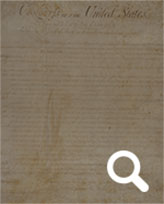Bicentennial of the Burning of Washington and the Battle of Baltimore
Bicentennial of the Burning of Washington and the Battle of Baltimore
The summer of 1814 saw military actions in Washington, DC, and Baltimore, Maryland, with dramatically different outcomes. The British capture of the nation’s capital and the destruction of public buildings stand as one of the lowest points in U.S. history. The American victory at Baltimore, however, brought new hope and determination to the country, and inspired what became the national anthem.
On August 19, 1814, British forces landed in Benedict, Maryland, and began marching toward Washington, DC. The generals and military leaders in DC were convinced that the British would have no reason to make the march to the capital, as it had only about 8,000 residents and a few half-completed federal buildings. However, the Redcoats’ intention soon became clear and the small, inexperienced, and untrained militia that remained to defend the city quickly marched up to meet the hostile forces at Bladensburg.
After defeating American troops at the Battle of Bladensburg on August 24, the British seized the undefended capital and burned government buildings, most famously the White House (then known as the Executive Mansion). Most private property was spared, and the patent building, one of the few federal buildings to be saved, survived thanks to Superintendent of Patents William Thornton who convinced the British that, while the building may be federally owned, patents were private property and shouldn’t be burned.
A few weeks later, beginning on September 12, the British attacked Baltimore by land and sea for three days. During the battle, American forces at Fort McHenry endured a 25-hour bombardment from British ships, while American militiamen stopped British advances on the city. On the morning of September 14, as the British retreated, the American flag still flew over Fort McHenry, signaling that the fort had not been taken. Inspired by the sight of the flag, Francis Scott Key, who was detained aboard a British ship, penned a poem in which he coined the phrase “Star Spangled Banner.” His poem “The Defence of Fort McHenry” was set to music and eventually became the National Anthem—with the same title as the flag that inspired it.
Records on display:
Letter from Maj. Gen. Samuel Smith to James Monroe about the bombardment of Fort McHenry, September 24, 1814
National Archives, Records of the Office of the Secretary of War
List of killed and wounded from Fort McHenry, September 24, 1814
National Archives, Records of the Office of the Secretary of War
Burned piece of the 1814 Executive Mansion (today known as the White House). The wood was removed during a renovation of the White House under the Truman administration from 1949-1952.
National Archives, Gerald R. Ford Presidential Museum
These records were on display in the “Featured Documents” exhibit in the East Rotunda Gallery of the National Archives in Washington, DC, September 11 through November 3, 2014.
The National Archives Museum’s “Featured Documents” exhibit is made possible in part by the Foundation for the National Archives through the generous support of Toyota.
Past Featured Records
-
Frances Perkins: Champion of Workers’ Rights
Thursday, February 29, 2024 – Monday, April 15, 2024
East Rotunda Gallery“I came to Washington to work for God, FDR, and the millions of forgotten plain common workingmen.” —Frances Perkins
Chances are you benefit from the legacy of Frances Perkins,... Read more
70th Anniversary of Brown v. Board of Education of Topeka
Thursday, February 1, 2024 – Wednesday, February 28, 2024
East Rotunda GalleryEquity in Education: 70 Years Later
On May 17, 1954, the Supreme Court delivered a unanimous ruling in Brown v. Board of Education of Topeka that “separate but equal” was unconstitutional in... Read more
250th Anniversary of the Boston Tea Party
Thursday, December 14, 2023 – Wednesday, January 31, 2024East Rotunda GalleryThe Destruction of the Tea
It wouldn’t be known as the “Boston Tea Party” for another 50 years, but the destruction... Read more
Diseños: An Impact of Mexican Cession
Tuesday, June 20, 2023 – Wednesday, October 18, 2023
East Rotunda GalleryAt the end of the Mexican-American War, the United States annexed more than half of Mexico’s territory under the 1848 Treaty of Guadalupe Hidalgo. Under its terms, the U.S. promised to... Read more
Celebrating Anna May Wong
Anna May Wong
National Archives, Records of the Immigration and Naturalization Service“I want to be an actress, not a freak.”
Film legend Anna May Wong’s talent could not be contained by the racist casting of early Hollywood movies. Born Wong Liu Tsong in Los Angeles in 1905,... Read more








